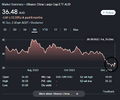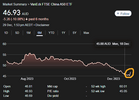Yeah really dont even try so my tactic is generally to just trickle money into stuff on the way down.Ha. It's a sacrifice of profits by not jumping in too early.
Timing of exits is even more difficult
Then usually just sell all at once.
And yep selling is like 10 times harder than buying imo.










